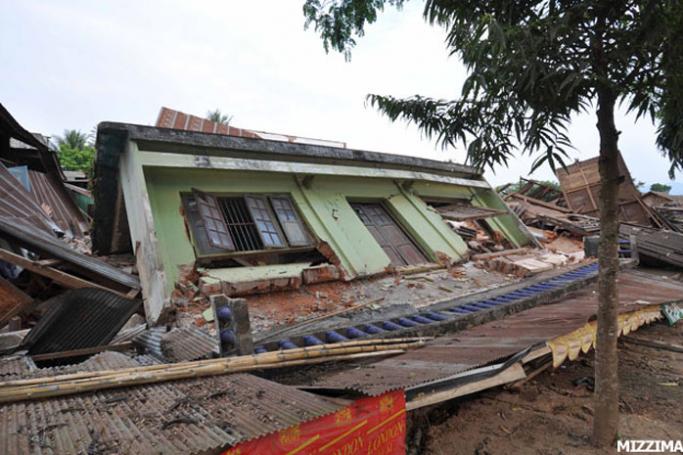Myanmar is exposed to a number of natural disasters and has a World Risk Index Ranking of 42/173 and Global Climate Risk Index of 2/178. GCR ranked Myanmar for the period 1995-2014 alongside Honduras and Haiti as the countries with the highest risk.
A crucial area in which steps are being taking to prepare is the threat posed by earthquakes. Such efforts in earthquake preparedness and messaging are crucial for Myanmar given the ever-present dangers posed by quakes.
Just weeks ago, there was a timely reminder when an earthquake hit 35 miles northwest of Monywa, Sagaing Region, affecting Kani, on November 27.
According to seismologist Soe Thura Tun: “An earthquake measuring 5.5 on the Richter scale hit. There is a big fault under the western mountain range. Small and moderate earthquakes occur regularly. The Chin Mountains, Monywa and western areas of Sagaing Region experience earthquakes annually."
No casualties were recorded, but Aung Tun Toe, deputy township administrator in Kani said: “Many pagodas were damaged, but we are still collecting data. No buildings collapsed."
That said, however, pagodas on the Shwe Myin Phyu Mountain either collapsed or suffered damage and three pagodas in Maung Htaung village in Butalin also collapsed.
The effect was most severe in Kani where buildings were not structurally strong enough, according to the Myanmar Earthquake Committee.
Earthquakes pose a hazard for many locations throughout the country as Myanmar is located on one of the two main earthquake belts in the world. During the 20th Century, at least, 18 serious earthquakes occurred along the Central Lowland in Myanmar where the Sagaing Fault passes.
Areas most vulnerable to earthquakes are Bago-Phyu, Mandalay-Sagaing-Tagaung, Putao-Tanaing, and Kale-Homalin. Important cities that lie in these areas are Taungoo, Taungdwingyi, Bagan-Nyaung-U, Kyaukse, Pyin Oo Lwin, Shwebo, Wuntho, Hkamti, Haka, Myitkyina, Taunggyi, and Kunglong.
In addition, coastal regions, particularly Rakhine State and the Ayeyarwady Delta Region, are also at high risk from cyclones, storm surges and tsunamis. Much of the country is also exposed to flooding and landslides during the rainy season in addition to drought and fire during the dry season.
With long-awaited political changes and a civil society in need of access to funding, capacity building and technical training, it is extremely important for international donors to invest in disaster preparedness and climate change adaptation in the country.
Sub-standard infrastructure and poor housing conditions contribute to Myanmar’s susceptibility. High casualties and economic loss are often related to the fall of non-engineered structures, it is essential therefore that the government implement new measures to ensure structural compliance with a view to ensuring new buildings are able to withstand future disasters, whether due to quakes, flooding or cyclones.
To help combat future problems, in 2012, the UN Office for Coordination of Humanitarian Affairs (UNOCHA) supported the development of the Disaster Management Law that passed in August 2013 as well as the Disaster Management Rules which were finalized in April this year.
According to the Disaster Management Law, the Government has established the National Disaster Management Committee (NDMC), the highest decision-making body for disaster management. The NDMC is chaired by Vice President II and the Minister of Social Welfare, Relief and Resettlement and the Minister of Home Affairs are the Vice-Chairs. Depending on the emergency Working Committees and Sub-Committees will be constituted and OCHA is supporting the government in linking these sub-committees with humanitarian coordination mechanisms.
Efforts are being made by to support awareness and training to help the Myanmar public in the case of a serious earthquake. One particular project is supported by UN-Habitat – through the Myanmar Consortium for Community Resilience, under the European Commission Humanitarian Aid department’s Disaster Preparedness Programme – and the Norwegian Ministry of Foreign Affairs.
As Myanmar progresses politically, it is hoped there will be further continued efforts to address the threats posed by natural disasters.
Sources: Give 2 Asia, earthquake track, earthquake report, UNOCHA
You are viewing the old site.
Please update your bookmark to https://eng.mizzima.com.
Mizzima Weekly Magazine Issue...
14 December 2023
Spring Revolution Daily News f...
13 December 2023
New UK Burma sanctions welcome...
13 December 2023
Spring Revolution Daily News f...
12 December 2023
Spring Revolution Daily News f...
11 December 2023
Spring Revolution Daily News f...
08 December 2023
Spring Revolution Daily News f...
07 December 2023
Diaspora journalists increasin...
07 December 2023
Bangladesh ships 1,600 refugees to controversial island












